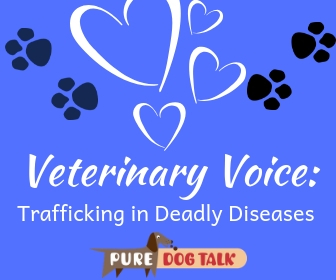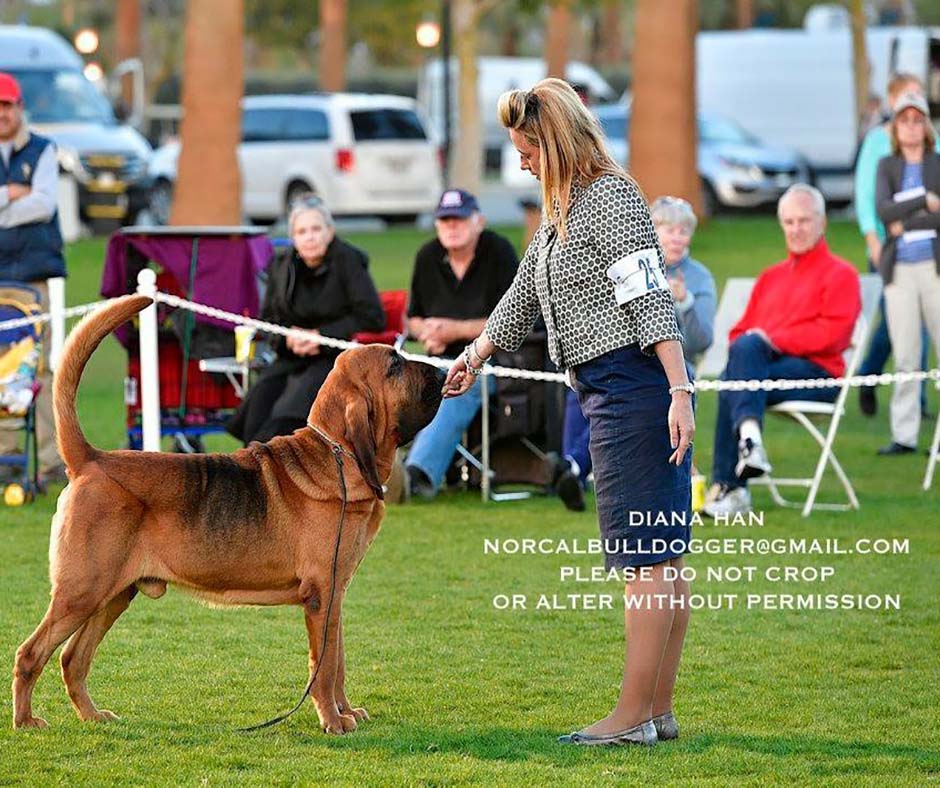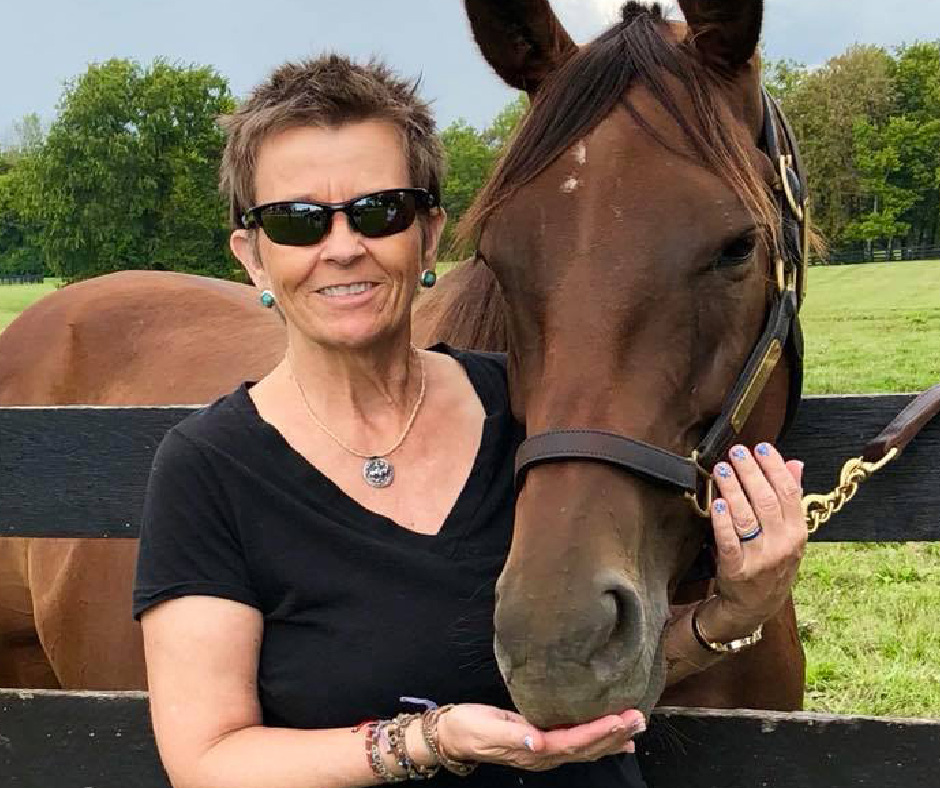276 – Trafficking in Deadly Diseases from Foreign “Rescues”

Trafficking in Deadly Diseases from Foreign “Rescues”
Our guest blog post today is from Nancy Melone, with additional information about the deadly diseases arriving with foreign “rescues.” Thank you for this outstanding research Nancy!
Protecting North American Dogs from Imported Disease Pathogens: The Cases of Dog Flu and Distemper*
By Nancy Melone, PhD, ThornCreek Bernese, Reg’d. and Eendenkoi Kooikerhondjes
Abstract: Protecting dogs and people from imported disease pathogens is a difficult and never-ending task requiring international cooperation and continued vigilance. The recent cases of dog flu and distemper offer vivid examples of the costs, both financial and emotional, of failure to responsibly import animals. This article describes the obstacles to such protection and the process of tracking and identifying unknown pathogens using dog flu and distemper as examples.
Protecting companion animals in the US from infectious organisms brought in by imported companion animals is not easy. Unlike the importation of food animals (e.g., cattle, sheep) which is overseen by the US Department of Agriculture, there is no federal oversight over the importation of companion animals. The only requirement for dogs entering the US or Canada is a rabies certificate. As became terrifyingly clear when several dogs imported from India, Iran, and Egypt were found to be rabid despite being “vaccinated,” fake rabies certificates are easy to obtain in some countries. Absent federal oversight, Professor Edward Dubovi, Director of the Virology Laboratory at Cornell University’s Animal Health Diagnostic Center, says, “It’s a 50-state free-for-all with regard to [importing] companion animals. It’s a very unsatisfactory situation if you’re trying to control infectious diseases in our domestic cats and dogs.”
The advent and popularity of international dog rescue and increased international and interstate trafficking of dogs has ushered in a new set of animal and human health concerns among infectious disease specialists, veterinarians, physicians, and epidemiologists as well as pet owners and breeders. Companion animals, in particular the family dog, are often seen as sentinels for known and unknown diseases in humans. They are the proverbial canary in the mineshaft. When dogs are imported from around the globe, they can become vectors of diseases that have never been seen in North America. Even diseases that have been eradicated and not seen in the US for decades may pose problems because of drug resistance. Many imported animals, particularly those rescued from underdeveloped or poor nations, enter North America with inadequate veterinary screening, veterinary care, or the benefit of basic vaccination protocols typical of dogs living in the US or Canada. In countries where dogs are raised for meat and regulation of antibiotics is poor, the risk of importing antibiotic-resistant pathogens is very high. Other factors further amplify disease risk, including, but not limited to, international rescue organizations who fail to develop and follow proper quarantine, disinfection and vaccination protocols. However well-intentioned, these rescue efforts put North American dogs at risk of foreign strains of potentially drug-resistant or unknown disease. Diagnosis of sick dogs becomes even more complicated in the case of unknown diseases, because if you have never seen or do not know what you are looking for, it is often hard to find it and when you do, it is often too late. To the extent imported dogs bring in unknown pathogens that are communicable to humans breeders, dog owners, rescuers, veterinarians, and adopters and their extended families are at potential risk.
The Case of Dog Flu
As many dog owners may recall, a primary focus in the last decade was the containment of two strains (H3N8 and H3N2) of the Canine Influenza Virus (CIV). So-called “dog flu” was unknown in the US until a mysterious illness struck racing greyhounds in Florida in 2003 and again in Texas in 2004. Rapid response by researchers and epidemiologists at Cornell and the University of Florida identified the virus as H3N8 and limited its spread. Retrospective analysis of stored lab samples indicated the virus, equine in origin, had been circulating in the US as early as 1999. In 2015, a larger outbreak of 1000 dogs occurred at a Chicago dog shelter. The virus (H3N2) was typed and found to be avian in origin. It was traced back geographically to China and South Korea and established that the virus had spread to the general dog population.
A vaccine for CIV exists now and is recommended for dogs at potential risk (e.g., show dogs, dogs attending activities such as training classes, doggie daycare or boarding at kennels). Unlike human flu, there is no “flu season” for dogs, so risk is nearly the same throughout the year for dogs.
Currently, CIV is not thought to be transmissible to humans (i.e., zoonotic). There has been no reported case of human infection with a canine influenza virus in the US or worldwide. In 2016, the Centers for Disease Control and Prevention (CDC) determined that the potential pandemic risk of CIV H3N2 viruses was low. However, according to Dr. Stephen Colodny, MD, Pittsburgh infectious diseases specialist, influenza viruses are constantly changing and H3N2 could mutate so that that CIV could infect people. CDC professionals worry that novel new non-human influenza A viruses against which humans have little immunity have the potential for causing an influenza pandemic.
The recent dog flu experience reminds us, too, that canine Imported pathogens not only risk the lives of domestic dogs and possibly humans, but also impose enormous costs on dog owners. Estimates of the cost of the 2015 CIV outbreak to US dog owners run as high as $75 million in diagnostic testing and vaccinations alone.
The Case of Canine Distemper Virus
Fast forward to early October 2018. The attention of epidemiologists shifted to a new pathogen. Twelve days after arriving in Western Canada, a 3-month old “Sheltie” puppy, allegedly rescued from a Korean dog meat facility, became mortally ill. The dog’s initial symptoms were lethargy and coughing. Bloodwork indicated that the dog had “anemia.” Approximately 10 days later, the dog developed involuntary muscle twitching and jerking on one side of the body (unilateral myoclonus) and relapsing lethargy. After another week, the dog suffered persistent tonic clonic seizures (e.g., unconsciousness, stiffened muscles and muscular jerking). When seizures worsened, the dog was euthanized.
The subsequent process of identifying the unknown pathogen was a directed search that involved international cooperation. Samples from the sick Korean-Canadian dog were sent to Cornell University’s Animal Health Diagnostic Center to see if the disease was H3N2 Canine Influenza Virus, which is the endemic strain of Influenza A in Korea. In addition, samples were tested for Canine Distemper Virus (CDV). Results were negative for flu, but swab and urine samples were strongly positive for distemper. Initial attempts to isolate the virus were unsuccessful, but later genetic analysis indicated that the virus was very similar to the Asia-1 strain of CDV. This lineage/clade is not among the native North American strains of CDV against which most dogs in the US are vaccinated. Indeed, Asia-1 had never been seen in the North America.
Canine Distemper is a highly contagious, systemic viral disease infecting dogs worldwide. It is transmitted dog-to-dog through the air by coughing or barking and through feces and urine. Occasionally there are CDV outbreaks at dog shelters, but for the most part CDV affects carnivorous wildlife populations including raccoons, grey fox, skunks, coyotes, and wolves. To the extent Asia-1 infects the carnivorous wildlife population, eradication is impossible. With regard to zoonotic potential, humans who have not had measles or who have not been vaccinated against measles are vulnerable to asymptomatic CDV. Scientists at Cornell indicate that “dogs already immunized against CDV likely are not at risk from the Asian strain.” Unvaccinated dogs and puppies who are too young to vaccinate may be at risk.
According to researchers at the University of Georgia, despite intensive vaccination programs in developed nations around the world, there is evidence recently of re-emergence and increased CDV activity worldwide, including in the US. This recent discovery of Asia-1 lends additional support to that conclusion. In the 2018 study (using samples from 2014 to 2017), Georgia researchers found after analyzing the CDV H gene that there are at least 3 different CDV lineages circulating in the US. These lineages included America-3, America-4, and a lineage previously reported in connection with an outbreak in Wyoming which was linked to a domestic dog breeding facility in Kansas in 2010. These lineages are not the same as the lineages found previously in the US, including America-1, which contains the majority of the vaccine strains. The researchers worry that these genetic differences could lead to vaccine failure. Analysis of other CDV-relevant genes produced similar results. The bottom line is that CDV requires continuous monitoring of circulating CDV strains in the US to prevent potential vaccine breakthrough.
What Do Concerned Dog Owners and Breeders Do?
As in all decisions involving risk, North American countries and dog owners must assess how much risk they are willing to tolerate and then develop coherent policies for managing those risks. International rescue organizations must take on the responsibility of not only helping international dogs at risk but also implementing protocols to protect domestic dogs from imported pathogens. Ideally, international rescue organizations would work to educate and place these rescued dogs in their countries of origin rather than importing them to North America. To the extent these organizations do not accept that responsibility, stricter domestic regulation of companion animal imports from high-risk regions should be pursued.
Domestic dog owners must also assess the risk for their own dogs in a world where imported unknown pathogens are likely. Since these risk assessments may vary across people, we may not all agree on the need for vaccines. If one chooses not to vaccinate, be aware that to achieve herd immunity, a substantial number (depending on contagion) of dogs must be vaccinated or have caught and survived disease. Ideally, herd immunity is reserved to protect those dogs (or humans) who cannot be vaccinated because they are pregnant, too young to be vaccinated, or because they are immune compromised because of age or disease. As such, herd immunity is not intended to protect healthy dogs who could be vaccinated with minimal risk.
The recent human measles outbreak illustrates the role vaccination and contagion rates play in achieving disease protection. For example, if we look at the recent outbreaks in both Washington state and New York state, the number of people who need to be vaccinated to obtain herd immunity for measles is around 95% because of the highly-contagious nature of measles. One measles-infected person infects on average about 15-18 other susceptible people. This rate of contagion is called the R0 (pronounced “R-naught”). In the New York outbreak, the number of vaccinated people had dropped to only 73%, considerably below the 95% necessary for herd immunity, hence given the highly contagious nature of measles, the outbreak was no surprise to public health officials. Such was also the case in Washington state. Measles, a preventable disease, kills many unvaccinated children and adults each year. Influenza is similar. We can easily translate these examples to the dog world.
Based on current information, if your dog attends training classes, dog shows, doggie day care or frequents areas where there are dogs of unknown vaccination status or wild animals (e.g., dog parks, community parks, rural areas) consider vaccinating your dog for CIV and CDV. If you cannot or wish not to vaccinate your dog, do not socialize him with unvaccinated dogs or take him to places where wild animals are likely to have urinated or defecated.
If you import a dog (an international rescue or a puppy from a breeder whom you do not know and with whom you do not have a trust relationship), revaccinate for rabies and DHPP, quarantine for 30 days, do a brucellosis test at day 1 and again at day 30. If the dog is healthy at day 30 and negative for brucellosis at day 30, you can probably introduce it safely to your dog family or breeding kennel.
According to Pittsburgh infectious disease specialist, Stephen Colodny, MD, in cases where there is a rare virus that does not warrant the substantial investment required for vaccine development, early detection and prompt treatment of those who are infected are critical in preventing human epidemics.
Conclusion
The threat of new and unknown pathogens to our dogs and dog owners is constant, requiring ongoing international cooperation and vigilance. While dog flu and the Asian strain of distemper occupy our current focus, there will always be new disease threats lurking around the corner because pathogens are adaptive, clever and stealthy. While the epidemiological process for discovering and identifying each of these threats may be similar, the work is difficult and never ending. Dog breeders and rescuers who bring foreign dogs into the country play a critical role in disease prevention. People who have no regard for the potential to import disease when importing dogs selfishly put us all at risk.
References
American Veterinary Medical Association, “Canine Influenza.” https://www.avma.org/KB/Resources/Reference/Pages/Canine-Influenza-Backgrounder.aspx, as viewed March 20, 2019.
Anis, E, Newell, TK, Dyer, N, and RP Wilkes, “Phylogenetic analysis of the wild-type strains of canine distemper virus circulating in the United States,” Virology Journal (2018) [15:11]8. Https://doi.org/10.1186/s12985-018-1027-2
Centers for Disease Control and Prevention. “Key FAQs about Canine Influenza (‘Dog Flu’)” https://www.cdc.gov/flu/other/canine-flu/keyfacts.html, as viewed March 20, 2019.
Cornell University College of Veterinary Medicine (Patricia Waldron), “New Strain of Sanine Distemper Virus Arrives in North America, March 18, 2019. Https://www.vet.cornell.edu/news/20190318/new-strain-canine-distemper-virus-arrives-north-america, as viewed March 20, 2019.
Acknowledgements
Special thanks to Stephen Colodny, MD, Pittsburgh human infectious disease specialist, Larry Gerson, VMD, and Marti Greer, DVM, both breeder-vets, for their helpful comments. I thank my breeder friends, Sandy Dunaway (Summit Bernese), Linda Seaver (Tschuggen Bernese), Cindy Valco (Summer St. Bernards) and Ann Knoop-Siderius (Iserman Kooikers) for helping me stay above the weeds so that average dog owners can find value in this article. I can never thank my proof readers/grammarians, Ellen Folke and Timothy W. McGuire, PhD., enough for their help throughout the years.
About the Author
Nancy P. Melone, PhD, is a graduate of the University of Minnesota in Information and Decision Sciences. Her articles on canine health have earned The Dog Writers Association of America’s Maxwell Medallion, the Morris Animal Foundation Advances in Canine Veterinary Medicine Award, and the American Kennel Club Publication Excellence Award. Dr. Melone formerly served on the boards of The Berner-Garde Foundation, Inc. and Bernese Auction Rescue Coalition (BARC), Inc. She is editor emerita of the BMDCA’s The Alpenhorn. Currently, she serves on the board of the Nederlandse Kooikerhondje Club of the USA and is chair of the Health and Genetics Committee.
*The author makes no warranties, expressed or implied, to representations of correctness of any content including, but not limited to, methods of diagnosis or recommendations of treatment. The information in this article does not substitute for appropriate professional veterinary medical care and treatment of your dog.
Our Valued Corporate Sponsors:
Our Esteemed Advertisers:
Our In-Kind Supporters:
KNOWLEDGE IS POWER — FRANCIS BACON
When you become a patron of Pure Dog Talk you’ll tap into an exclusive community of experts to help you and your dog be blue-ribbon best at whatever you do with your purebred dog! Your support helps keep the MP3's rolling at Pure Dog Talk!
As a supporter, you’ll immediately gain access to the weekly Pure Pep Talk SMS, Pure Pep Talk private Facebook group, and priority emails. Patrons can choose to level up to the After Dark Zoom and a Patrons Digital Badge for their website— even a private counseling session with Laura on any topic.

DON'T MISS AN EPISODE!!












